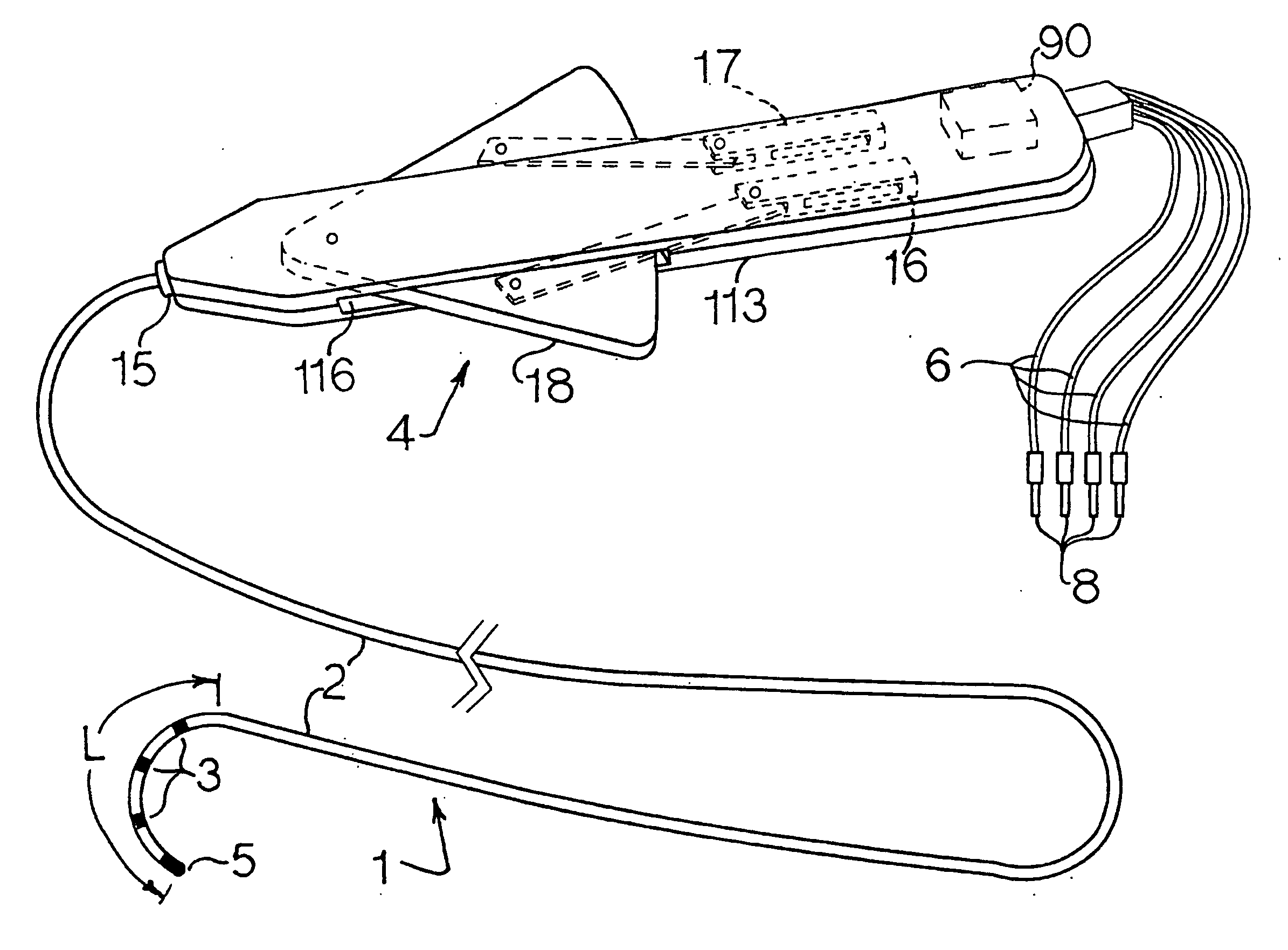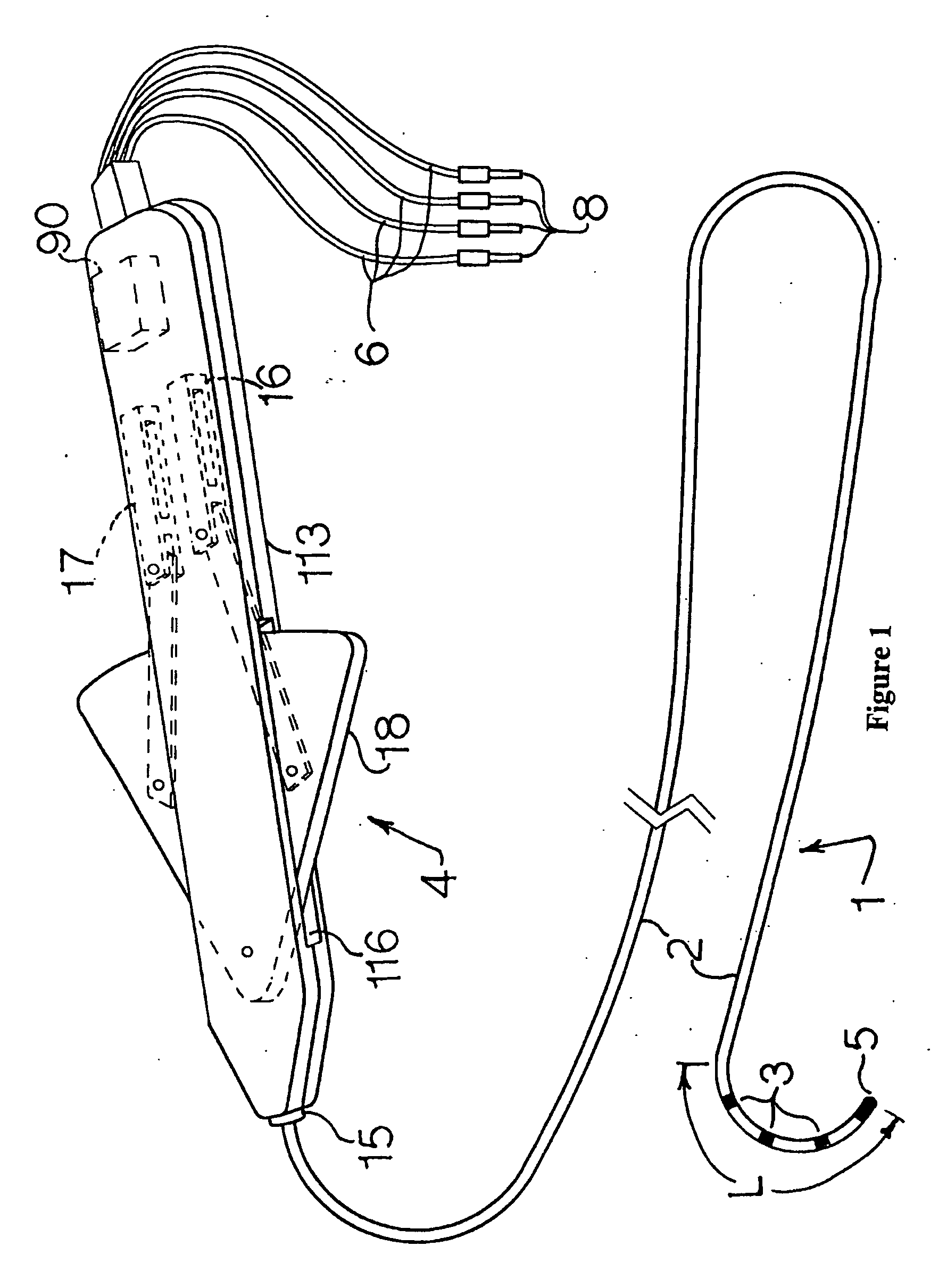Electrophysiology/ablation catheter and remote actuator therefor
a technology of electrophysiology and catheter, applied in the field of catheter, can solve the problems of difficult monitoring of cardiac signals contaminated with such “noise”, significant level of electrical “noise” generated, and relatively high cost of catheters of this type, so as to reduce the compression load of the inner guide tube, reduce the cost of catheter construction, and reduce the effect of insertion and removal
- Summary
- Abstract
- Description
- Claims
- Application Information
AI Technical Summary
Benefits of technology
Problems solved by technology
Method used
Image
Examples
embodiment 4
[0140] Referring to FIGS. 9, 10, 11, 12, and 13 an alternative embodiment 4′ of the catheter handle is shown with a cam-follower type pull / push mechanism for affecting formation of curvature at the distal portion of the catheter upon movement of actuator 128. The pivoted delta shaped actuator 128 is disposed to pivot freely about pin 43 within the handle 113′.
[0141] Referring to FIG. 10, the mechanism of handle 4′ comprises two symmetrically coupled followers 40 and 41 disposed for sliding movement on block 113′ and with a single rotating cam 42 as the driver. The cam 42 is rigidly attached to the apex of the delta-shaped actuator 128 for rotation therewith. The center 44 of cam 42 is pivoted within the catheter handle body 113′ about a pin 43.
[0142] The two sliding followers 40 and 41 are driven by cam 42. Each of the sliding followers 40 and 41 includes an adjusting screw 45 and 46 respectively. The tip of each of these adjusting screws 45, 46 are anchored to the cam profile and ...
embodiment 154
[0159] The second sub-system 61 of the embodiment 154 comprises the front or left hand portion of the catheter handle end and includes:
[0160] a cylindrical housing 73;
[0161] a manual back-up actuator 74 in the form of a tubular member disposed concentrically over housing 73;
[0162] a motor control switch 75;
[0163] the multi connector junction jack 69 is disposed inside the right hand end of the cylindrical housing 73;
[0164] a connecting rod or pin 76 interconnects manual drive actuator 74 to core 72 through a slot 82 formed in housing 73;
[0165] a front bearing support 77 is disposed in housing 73 adjacent the left end thereof;
[0166] a rear bearing support 78 is disposed in housing 73 adjacent the right hand end thereof; and,
[0167] an angular displacement sensor 79 is disposed in housing 73 and located at the right hand end thereof for sensing rotation of core 72 with respect to housing 73 of sub-system 61.
[0168] The core 72 of sub-system 61 includes two identical pull / push me...
embodiment 170
[0178] The embodiment 170 includes an additional annular reference electrode 103 on the catheter main exterior tube 2 for a uni-polar application of the catheter during intra-cardiac mapping procedures. In addition, the catheter 170 may include a blood-clot sensor or detector (not shown) and a temperature indicator (not shown) in the catheter handle 4. The purpose of blood clot sensor is to stop or reduce the delivery of electrical energy to the heating element during ablation procedures.
[0179] Referring to FIGS. 20a through 20d a further embodiment 180 of the catheter of the present invention is illustrated and has the feature that the blood contacting portions are disposable; and, thus, the embodiment 180 is particularly suitable for cardiac electrophysiology / ablation procedures. The embodiment 180 is a modified version of the catheter presented in FIG. 1 of this invention. The modification is applied in two parts. The first modification pertains to the shape of the distal tip ele...
PUM
 Login to View More
Login to View More Abstract
Description
Claims
Application Information
 Login to View More
Login to View More - R&D
- Intellectual Property
- Life Sciences
- Materials
- Tech Scout
- Unparalleled Data Quality
- Higher Quality Content
- 60% Fewer Hallucinations
Browse by: Latest US Patents, China's latest patents, Technical Efficacy Thesaurus, Application Domain, Technology Topic, Popular Technical Reports.
© 2025 PatSnap. All rights reserved.Legal|Privacy policy|Modern Slavery Act Transparency Statement|Sitemap|About US| Contact US: help@patsnap.com



